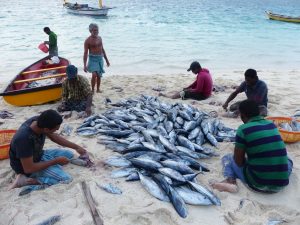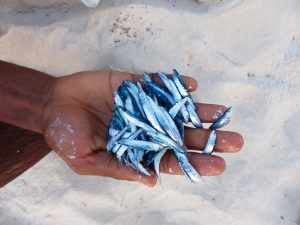A community-based, bottom-up regime of fisheries management, rooted in traditional ecological knowledge, is practised in the pole-and-line tuna fishery of India’s Lakshadweep Islands
This article is by Prerana Gawde (prerana@dakshin.org) and Ajithraj R (ajithraj@dakshin.org) of Dakshin Foundation
India is home to a large number of small-scale fishers (SSF) using diverse craft-gear combinations along the country’s long coastline and island systems. One standout entry is the pole-and-line (P&L) tuna fishery of the Lakshadweep Islands. Compared to other fisheries, this is not mentioned much in the outside world—or even on the Indian mainland. Yet this unique and sustainable fishery deserves a sharper focus during the ongoing International Year of Artisanal Fisheries and Aquaculture (IYAFA).
The P&L fishing gear comprise a fishing line with a barbless hook attached to a bamboo or fibreglass pole. The fishing method uses plenty of live fish as bait to attract the tuna. The ‘baitfish’ are small pelagic and reef fishes caught from lagoons and reefs surrounding the islands. P&L fishing is considered one of the most sustainable fishing methods.
P&L fishing is practised across the Atlantic, the Pacific and the Indian oceans, with minor-to-significant variations. For example, the Japanese P&L fleet is highly mechanized with robotic pole-and-line apparatus; the main boat is supplied with fresh, live baitfish from time to time. Meanwhile, in Senegal, multiple P&L boats first collect reliable amounts of baitfish and then proceed to fish for tuna, together using each other’s boats as huge fish aggregating devices (FADs).
In Lakshadweep, the P&L fleet consists of vessels 40-60 feet long and crews of 8-12 fishers. They begin their fishing day with baitfish fishing and then proceed to catch tuna. Baitfish are kept alive in aerated holding tanks onboard fishing vessels before being used as bait for P&L fishing. Fishers locate and approach tuna schools in the open sea by taking cues from the preying seabirds or, at times, with the help of FADs.
On locating a school of tuna, fishers throw the live, shiny baitfish from the boat to attract the tuna toward the boat. Fishers onboard scatter baitfish and simultaneously spray water to mimic a feeding frenzy for tuna. In this situation, the tuna start biting on anything shiny, even the silvery hooks. As the tuna takes the bait, the fishing crew standing at the back of the boat with their fishing poles immediately cast their lines into the tuna school. On hooking a tuna, the fishers skilfully hurl it onto the deck behind. The barbless hooks make it easy to disengage the entangled tuna with a mere flick of the hand; the fishing continues, one tuna at a time, till the feeding frenzy ceases.
The P&L fishery has a low impact on the marine ecosystem. Being an offshore operation, it alleviates the fishing pressure on the islands’ sensitive coral reef ecosystem. It makes a major contribution to the socioeconomic well-being of the community, being a primary source of income for a significant number of Lakshadweep’s residents. It contributes nearly 15 per cent to India’s total tuna landings, as of 2019.
The P&L technique is said to have evolved centuries ago in the islands of the Indian Ocean, including Minicoy, the southernmost island of Lakshadweep
The P&L technique is said to have evolved centuries ago in the islands of the Indian Ocean, including Minicoy, the southernmost island of Lakshadweep. The Lakshadweep Fisheries Department introduced the technique from there to other islands in 1963. Initially, it was backed by development programmes, policies and subsidies to enhance the livelihoods of the local fishers. Now, it has acquired a more production-centric path because of supportive policies and incentives for multi-day fishing and scaling-up production. These policies have intensified fishing activities on the islands and have subsequently increased fishing pressure, not only on the tuna resources but on the baitfish resources as well. Baitfish are a critical limiting resource.
Challenges ahead
The last ten years have seen an increase in the size and number of P&L boats in Lakshadweep due to policies and subsidies that are encouraging higher tuna catches. This has consequently led to an increased demand for bait, subsequently intensifying baitfish fishing. For example, over the past few years, many boats have been fishing for baitfish species like the silver striped herring (Spratelloides gracilis) using ‘light fishing’, employing artificial light emitting diode (LED) from night time till before dawn, to attract the baitfish.

Although the short-term benefits of using artificial lights to attract fish are undeniable—higher catches, less effort, fuel savings—experts have demonstrated its negative effects like overfishing and increased bycatch. The herrings form spawning aggregations before dawn; they are drawn towards the lights and then caught. This can impair recruitment and affect local baitfish stocks. A majority of fishers reported that light fishing is a major reason for the perceived decline in the availability of baitfish. Continued light fishing can endanger the sustainability of baitfish stocks.
The increased demand for—and declining availability of—baitfish has made fishing arduous. Fishers now spend more time, fuel and labour searching for bait, increasing costs. Salahudeen, a P&L fisher from the island of Agatti with the highest number of tuna fishers, said, “Earlier, we would begin baitfish fishing at daybreak; there was ample baitfish for all. Now, everybody rushes to the fishing ground before dawn or even at midnight to land enough baitfish for the day.”
While there is a lack of information on the exact magnitude of the impact of such fishing practices on Lakshadweep’s baitfish stocks, it is vital to take prudent precautionary measures to manage these resources sustainably.
Masmin, the smoked staple
Masmin or hiki mas is a smoked and sun-dried product of Lakshadweep’s tuna; the processing increases its shelf life. It is similar to the Japanese Katsuobushi and Velho mas of the Maldives. This processing technique has spread through the Lakshadweep islands along with P&L fishing. As of 2015, over 90 per cent of Lakshadweep’s P&L caught tuna is converted into masmin. Very likely, this is due to the absence of infrastructure to store and transport fresh fish to the mainland.
Lakshadweep masmin is mainly exported to Sri Lanka and Southeast Asian countries through supply chains consisting of traders and agents from the Indian mainland. This complete dependence on a handful of traders has created a monopoly in the market. Owing to this market structure, a slight disruption in the supply chain can make fishers highly vulnerable to price volatility.
This was evident during the COVID-19 pandemic. The price of masmin halved from INR350-500 (US$4) per kg to INR120-180 (US$2) per kilo, exposing the vulnerabilities of fishers due to their reliance on a single supply chain. This freefall worsened the fishers’ limited access to markets and low value for their masmin.
In transition
Direct and indirect socioeconomic or ecological challenges can push small-scale fisheries towards unsustainable practices. With the P&L fishery facing issues like declining baitfish resources and the lack of adequate returns, Lakshadweep’s fisheries are seeing a transition to reef fishing, adding pressure on the sensitive coral reef systems that constitute this archipelago.
Lakshadweep is also facing intrusion of illegal, foreign and mainland Indian fishing boats into its waters, a concern for many fishers. Moreover, changing developmental priorities of the government present other external challenges. For example, there is currently a push for large-scale tourism development in Lakshadweep. This can negatively impact the islands’ fisheries sector, limiting fishers’ access to fishing grounds and the coastal commons.
Although tourism can be encouraged, its implementation has to take an equitable and balanced approach by considering the concerns of the fisheries sector that is critical for the livelihood of the Lakshadweep’s population. Tourism models must be compatible with the unique social-ecological context of the islands.
Fisheries management now
Despite the complexities and challenges of P&L fisheries, there is a dearth of active cooperatives to help fishers undertake collective action to address pressing issues. The islands have had collectives in the past; they did not endure, with the exception of those initiated by the fisheries department. These societies are primarily engaged in selling boat spare parts and providing other fishery-related services.
… there also exists a community-based, bottom-up regime of fisheries management on Minicoy Island, from where P&L was introduced to the other islands
Decisions concerning fisheries in Lakshadweep are made within a conventional, top-down, bureaucratic system; the directives that trickle down the hierarchy are designed to fulfil the overarching national fisheries goals. Such a bureaucratic system is beneficial in driving government interventions, it does not necessarily reflect the nuances and complexities of issues at the local level. Lakshadweep’s P&L fishery faces complex, multi-dimensional and ever-changing challenges. They require holistic solutions developed through multi-stakeholder involvement.

In addition to the conventional, top-down management system, there also exists a community-based, bottom-up regime of fisheries management on Minicoy Island, from where P&L was introduced to the other islands. Minicoy Island has its customary systems of resource management, rooted in traditional ecological knowledge, preventing the overharvest of resources. Learning from such unique examples and, wherever possible, incorporating their elements into contemporary fisheries management could be a step towards making resource management more inclusive, contextualized and sustainable.
Tiding over the challenges
What remains undisputed for enabling inclusive fisheries governance is awareness, motivation and empowerment among stakeholders. Dakshin Foundation, an organization working on coastal and marine systems in India, has been engaged in research and interventions aimed at preserving the P&L fishery and creating systems for participatory fisheries management in Lakshadweep for almost a decade. Dakshin’s Community-Based Fisheries Monitoring (CBFM) programme is aimed at empowering fishers through participatory knowledge generation for long-term and sustainable management.
The CBFM programme has gained traction among the fishers over the years. It has provided a good entry point for mobilizing support for making decision-making more inclusive. In turn, this has fostered dialogue around the creation of a multi-stakeholder fisheries governance platform in Lakshadweep.
The initial consultations on this front have been favourable. Getting various stakeholders together to operationalize such a platform requires more work. Such participatory governance systems have the potential to go beyond resource management; they can enable fishers and other stakeholders to collectively address the larger challenges facing the island fisheries.
The way forward
The ongoing IYAFA period that celebrates small-scale and artisanal fisheries is not merely a reminder to the world about the significance of SSF like the P&L fishery. In fact, it compels us to ask critical questions about ensuring equity and justice for small-scale fishers, fishworkers and their communities. It is imperative to address these questions now, in the face of the rapacious pursuit of fish in a hamstrung environment.
To ensure a viable future, we strongly recommend the need for well-coordinated action at local and national levels. This will ensure fishers’ participation across the various levels of resource management through novel and dynamic approaches like participatory, community-based or cross-scale governance. Investing in small-scale fisheries in this way can be a global investment toward a sustainable future for fisheries and healthier oceans.
For more
Where Tradition is a way of life: Traditional Knowledge in the U.T of Lakshadweep, India
https://www.icsf.net/resources/where-tradition-is-a-way-of-life-traditional-knowledge-in-the-u-t-of-lakshadweep-india-2/
Dakshin Lakshadweep Fisheries
https://www.dakshin.org/lakshadweep-fisheries/